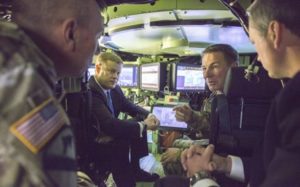As the Army continues to push toward building autonomous capabilities into its next-generation combat vehicles and aircraft, the service’s chief said Tuesday he envisions a ‘minimally-manned’ fleet of platforms rather than moving to completely unmanned systems.
“A lot of people look at artificial intelligence and machine learning and think that we’re going to have all autonomous vehicles or aircraft out there fighting the future fights. I don’t see it that way. What I see, especially in the near-term, is where we’re going to be able to go maybe to more minimally manning,” Gen. James McConville, the Army’s chief of staff, told attendees at an Atlantic Council event.

The Army is exploring autonomous operations for major modernization efforts such as the Bradley-replacing Optionally-Manned Fighting Vehicle as well as its Future Vertical Lift helicopter programs.
Bell [TXT] confirmed to reporters last week the company had completed a successful autonomous test flight in December with the V-280 tiltrotor aircraft being offered for the Army’s Future Long Range Assault Aircraft program (Defense Daily, Jan. 9).
McConville noted the Army’s vision for autonomy should include the ability to adjust the number of personnel required to be on the platform rather than having to be restricted to a binary decision of manned or unmanned.
“If we’re going to move a large amount of troops, and have a Ranger unit or something like that going in, I don’t necessarily see us putting them in an aircraft and having no one up front,” McConville said. “But I could see where we maybe don’t need a four-person crew because the aircraft knows how to navigate. The aircraft would do a lot of those types of things.”
Following his discussion, McConville reiterated to reporters that he believes there is still value in keeping a limited amount of personnel on future platforms to maintain situational awareness and safety measures if an autonomous capability happens to malfunction.
“There are times when unmanned systems are good and there are times when you want a person there, because you can’t feel it when you’re not there,” he told reporters.